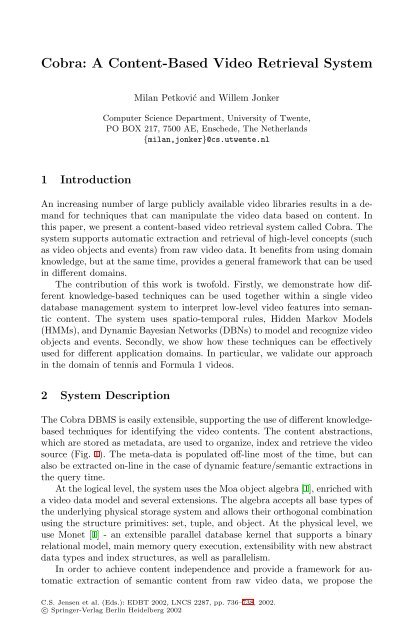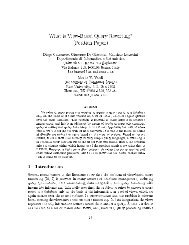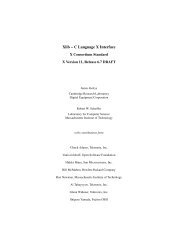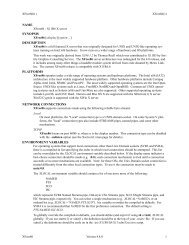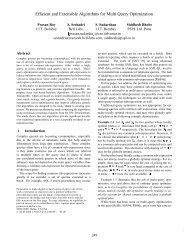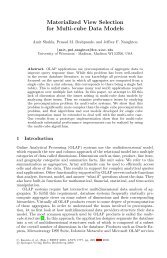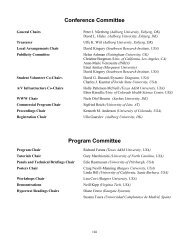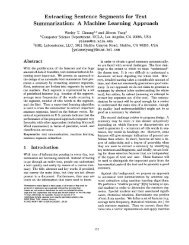Cobra: A Content-Based Video Retrieval System
Cobra: A Content-Based Video Retrieval System
Cobra: A Content-Based Video Retrieval System
Create successful ePaper yourself
Turn your PDF publications into a flip-book with our unique Google optimized e-Paper software.
<strong>Cobra</strong>: A <strong>Content</strong>-<strong>Based</strong> <strong>Video</strong> <strong>Retrieval</strong> <strong>System</strong>Milan Petković and Willem JonkerComputer Science Department, University of Twente,PO BOX 217, 7500 AE, Enschede, The Netherlands{milan,jonker}@cs.utwente.nl1 IntroductionAn increasing number of large publicly available video libraries results in a demandfor techniques that can manipulate the video data based on content. Inthis paper,we present a content-based video retrieval system called <strong>Cobra</strong>. Thesystem supports automatic extraction and retrieval of high-level concepts (suchas video objects and events) from raw video data. It benefits from using domainknowledge,but at the same time,provides a general framework that can be usedin different domains.The contribution of this work is twofold. Firstly,we demonstrate how differentknowledge-based techniques can be used together within a single videodatabase management system to interpret low-level video features into semanticcontent. The system uses spatio-temporal rules,Hidden Markov Models(HMMs),and Dynamic Bayesian Networks (DBNs) to model and recognize videoobjects and events. Secondly,we show how these techniques can be effectivelyused for different application domains. In particular,we validate our approachin the domain of tennis and Formula 1 videos.2 <strong>System</strong> DescriptionThe <strong>Cobra</strong> DBMS is easily extensible,supporting the use of different knowledgebasedtechniques for identifying the video contents. The content abstractions,which are stored as metadata,are used to organize,index and retrieve the videosource (Fig. 1). The meta-data is populated off-line most of the time,but canalso be extracted on-line in the case of dynamic feature/semantic extractions inthe query time.At the logical level,the system uses the Moa object algebra [1],enriched witha video data model and several extensions. The algebra accepts all base types ofthe underlying physical storage system and allows their orthogonal combinationusing the structure primitives: set,tuple,and object. At the physical level,weuse Monet [1] - an extensible parallel database kernel that supports a binaryrelational model,main memory query execution,extensibility with new abstractdata types and index structures,as well as parallelism.In order to achieve content independence and provide a framework for automaticextraction of semantic content from raw video data,we propose theC.S. Jensen et al. (Eds.): EDBT 2002, LNCS 2287, pp. 736–738, 2002.c○ Springer-Verlag Berlin Heidelberg 2002
<strong>Cobra</strong>: A<strong>Content</strong>-<strong>Based</strong> <strong>Video</strong> <strong>Retrieval</strong> <strong>System</strong> 737Fig. 1. The architecture of the <strong>Cobra</strong> systemCOntent-<strong>Based</strong> RetrievAl (COBRA) video data model (a detailed descriptioncan be found in [2]). The model is in line with the latest development in MPEG-7,distinguishing four distinct layers within video content: the raw data,thefeature,the object and the event layer. The object and event layers are conceptlayers consisting of entities characterized by prominent spatial and temporaldimensions,respectively. By using this model,we achieved insulation betweenapplications and feature/semantic extraction techniques on one hand,and dataon the other hand.The techniques,which are used to inference high-level semantics from rawvideo data,are integrated within the system as Moa/Monet extensions. In thecurrent implementation we have three extensions: (1) <strong>Video</strong> processing and featureextraction,(2) HMM,and (3) rule-based extension.The video-processing and feature-extraction extension encapsulates operationsused for video segmentation,processing and feature extraction. Operationsare implemented using Matlab and its image processing toolbox and as such usedthrough a Matlab server directly by the system.The other two extensions are tightly coupled with the system. The rule-basedextension is implemented within the query engine. It is aimed at formalizing descriptionsof high-level concepts,as well as their extraction based on features andspatio-temporal reasoning. The HMM extension implements two basic HMM operations:training and evaluation. Here,we exploit the parallelism of our databasekernel and implement the parallel evaluation of different HMMs at the physicallevel. For a more detailed description of these two extensions see [2].By extending the system at all levels,several knowledge-based techniqueshave been efficiently integrated within our VDBMS. This is an important advantageover approaches that implement a video extension at the applicationlevel,which results in a much slower system.
738 Milan Petković and Willem Jonker3 <strong>Content</strong>-<strong>Based</strong> <strong>Retrieval</strong>Having described our system and the model,this section explains how highlevelconcepts are extracted from raw video data. We start with segmenting avideo into different shots using differences in the color histograms of neighboringframes. Then,shots are classified in different categories. Note that from thatstep,domain knowledge starts to play a very important role,since the shot classificationand event recognition are domain dependent. We continue the processby extracting visual features characterizing color,shape,texture and motion,aswell as audio features. In our system we use general,but also domain specificfeatures,such as skeleton features in the tennis domain [2]. Having the featuresextracted we use domain knowledge coupled with the aforementioned techniquesto map them to high-level concepts.In our experiments,we applied spatio-temporal formalization of video objectsand events using rules. In that way,we were able to describe,for example,atennis player as a video object,and playing close to the net or rallies as videoevents. Consequently,we were able to interactively query the database for videosegments with these semantic concepts. However,this rule-based approach isessentially restricted to the extent of recognizable events,since it might becomedifficult to formalize complex actions of non-rigid objects using rules. In orderto solve this problem,we have exploited the automatic learning capability ofHMMs. In our tennis case study,they have been used to recognize differenttennis strokes. The results of large experiments we run showed that we were ableto recognize six different tennis strokes,namely,forehand,backhand,service,smash,forehand volley and backhand volley,with the accuracy of 88%. Thestroke recognition provides our system with the ability to answer even moredetailed queries such as: retrieve all video sequences with Sampras approachingthe net with the backhand stroke.On the other hand,to demonstrate the generality of our approach,we havealso done some experiments in the domain of Formula 1 videos [3]. Here,weemployed dynamic Bayesian networks to find the highlights of Formula 1 programs.We extracted different multi-modal cues (namely text,audio and visualcues) and found that DBNs are very useful for fusing them. The accuracy ofabout 80% was obtained compared to the human annotation. To the best of ourknowledge this is the first time that dynamic Bayesian networks are used forindexing and characterization of TV broadcasting programs.References1. P. Boncz, A.N. Wilschut, M.L. Kersten. Flattering an object algebra to provideperformance. In Proc. IEEE Intl. Conf. on Data Engineering, pages 568-577, 1998.2. M. Petković, W. Jonker. <strong>Content</strong>-<strong>Based</strong> <strong>Video</strong> <strong>Retrieval</strong> by Integrating Spatio-Temporal and Stochastic Recognition of Events. In Proc. IEEE International Workshopon Detection and Recognition of Events in <strong>Video</strong>, pages 75-82, 2001.3. V. Mihajlović, M.Petković. Automatic Annotation of Formula 1Races for <strong>Content</strong>-<strong>Based</strong> <strong>Video</strong> <strong>Retrieval</strong>, CTIT Technical Report, TR-CTIT-01-41, 2001.


